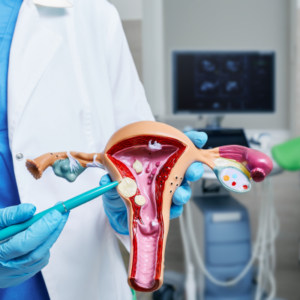 Myomectomy is a surgical procedure specifically designed to remove uterine fibroids, also known as myomas or leiomyomas, which are non-cancerous growths in the uterus. Fibroids are common among women of reproductive age and, while often harmless, they can sometimes lead to significant health issues such as heavy menstrual bleeding, pelvic pain, and fertility complications. Myomectomy offers a targeted solution, allowing women to preserve their uterus and, potentially, fertility while addressing the symptoms caused by fibroids.
Myomectomy is a surgical procedure specifically designed to remove uterine fibroids, also known as myomas or leiomyomas, which are non-cancerous growths in the uterus. Fibroids are common among women of reproductive age and, while often harmless, they can sometimes lead to significant health issues such as heavy menstrual bleeding, pelvic pain, and fertility complications. Myomectomy offers a targeted solution, allowing women to preserve their uterus and, potentially, fertility while addressing the symptoms caused by fibroids.
Types of Myomectomy
There are several types of these procedures, and the choice of method depends on factors such as the number, size, and location of the fibroids. The main types are:
- Hysteroscopic: This minimally invasive procedure is used for fibroids located inside the uterine cavity. A surgeon inserts a small camera, called a hysteroscope, through the vagina and cervix into the uterus. With specialized instruments, the surgeon removes the fibroids without making any external incisions. This approach is typically outpatient and has a shorter recovery time.
- Laparoscopic: Ideal for smaller fibroids on the outer or middle layers of the uterus, laparoscopic myomectomy involves a few small incisions in the abdomen through which a camera and surgical tools are inserted. The surgeon removes the fibroids with precision, and in some cases, robotic assistance is used. This minimally invasive method typically allows for a quicker recovery than open surgery.
- Abdominal (Laparotomy): For large or numerous fibroids, an open abdominal myomectomy is sometimes necessary. It involves a larger incision, providing the surgeon with full access to the uterus. Though recovery is longer for this procedure, it remains an effective solution for those with complex fibroid cases.
Why Choose Myomectomy?
This procedure is often chosen by women who wish to preserve their uterus, especially those hoping to maintain or restore fertility. Unlike a hysterectomy, which removes the entire uterus, myomectomy is a more conservative option that targets only the fibroids. The primary benefits include:
- Symptom Relief: Fibroids can cause debilitating symptoms such as heavy menstrual bleeding, prolonged periods, pelvic pain, and bloating. This procedure removes the fibroids, which helps alleviate these symptoms.
- Fertility Preservation: For women planning a future pregnancy, myomectomy is often preferred over hysterectomy. By retaining the uterus, many women who choose this procedure have improved chances of conceiving post-surgery.
- Improved Quality of Life: For women whose lives are disrupted by fibroid symptoms, it can provide significant relief and enhance their overall quality of life.
Risks and Considerations
Like any surgical procedure, myomectomy carries some risks. Potential complications include infection, excessive bleeding, and, in rare cases, scar tissue formation within the uterus. Another possible risk is fibroid recurrence; while myomectomy removes existing fibroids, it does not prevent new fibroids from developing.
In addition, the type of myomectomy can impact a woman’s fertility and pregnancy outcomes. Women who undergo an abdominal myomectomy, for instance, may be advised to have a cesarean section in future pregnancies to avoid risks associated with uterine rupture. It’s crucial for women to discuss their family planning goals and surgical options with their healthcare provider to determine the best approach for their situation.
Recovery
The recovery period varies depending on the type of procedure performed. For hysteroscopic and laparoscopic myomectomies, recovery typically takes one to three weeks. In contrast, abdominal myomectomy may require a recovery period of four to six weeks. During recovery, patients are advised to avoid heavy lifting and strenuous activities to ensure proper healing. Pain management, hydration, and a balanced diet are also important aspects of recovery.
Follow-up visits are essential to monitor healing, and some women may benefit from additional therapies to manage symptoms or reduce the risk of fibroid recurrence. Additionally, those seeking pregnancy are often advised to wait several months post-surgery to allow for full uterine healing.
We’re Here For You
If you’ve been diagnosed with symptomatic uterine fibroids, myomectomy is a valuable option, particularly those who wish to preserve their fertility and improve their quality of life. By removing fibroids and addressing related symptoms, myomectomy can have a significant positive impact. Consultation with one of our board-certified OB/GYNs helps determine the most appropriate type of myomectomy, taking into account the individual’s symptoms, future reproductive plans, and overall health goals. Call us today at 770.720.7733 or schedule an appointment online.


